The Cornell Lab Bird Academy › Discussion Groups › Virtual Educator Retreat: Inspiring Investigations through Citizen Science › Virtual Educator Retreat: Encouraging Observations
-
Bird AcademyBird AcademyWhat was the most impactful thing about creating your sound map? How might you encourage the children you teach to use their senses to observe the natural world more fully? Share your thoughts in the comment box below, and add an image of your sound map by clicking the small “image” icon under the comment box.
- The forum ‘Virtual Educator Retreat: Inspiring Investigations through Citizen Science’ is closed to new topics and replies.
-
The most impactful thing about creating a sound map is it forces you to be still and focus your attention. It might help some of my more active students to slow down and really take in what they hear.

-
This was pretty relaxing and forced me to sit still for a little bit longer than I am used to. I think this would be a great way to calm students down and really get in touch with the environment. I know that some students would have a great difficultly (trouble staying still, wanted to know how the assignment was getting graded), but after the year we have had, it might be something to really relax them.

-
Ashley, I agree! With the year we have had, this may be a great thing to help kids get calm.
-
-
 This was a great excuse to go sit outside in the evening! We will be starting a water quality project with students in the fall and doing something similar to this where they could sit and observe all the water in their surroundings could be a neat way to have them start thinking of sources of water and from that research questions. It also breaks down an overwhelming place (the outdoors) into things I can identify or simply notice.
This was a great excuse to go sit outside in the evening! We will be starting a water quality project with students in the fall and doing something similar to this where they could sit and observe all the water in their surroundings could be a neat way to have them start thinking of sources of water and from that research questions. It also breaks down an overwhelming place (the outdoors) into things I can identify or simply notice. -
Hello Jenny, My 5th graders do a water unit. I love your idea of having students make observations of all the water in their surroundings! I am going to "borrow" this idea!
-
-
I have done this campers and instead of drawing or writing what was making the sound.. they had to draw the " sound". Rachel and some others did that in their maps. It can be challenging way of listening, because we love to label and identify.
-
 In creating my soundmap I am reminded how many natural sounds there are around us, particularly birds, even though we live in the city. I like April's thoughts on using this activity as a mindfulness exercise for her students. I first discovered sound maps in Joseph Cornell's books. April, there are other minful-type nature activities in his works if you're interested.
In creating my soundmap I am reminded how many natural sounds there are around us, particularly birds, even though we live in the city. I like April's thoughts on using this activity as a mindfulness exercise for her students. I first discovered sound maps in Joseph Cornell's books. April, there are other minful-type nature activities in his works if you're interested. -
The most impactful thing about creating my sound map is the way it loosens you up and helps you pay attention to things you may have normally missed. Closing your eyes helps pique your listening and slows your brain down from what are otherwise distractions. This is a lesson I have used for students across the learning spectrum. I teach a wide range of students, from those with very high-needs to those enrolled in science research skills. I use it as a mindfulness lesson. I open the lesson by taking them outside, record their heartrate before this exercise, then we practice a breathing exercise before taking 5 minutes to do the sound map. After doing so, we again take/record a heart bpm. Mostly, students see their heart rate drop and feel more relaxed which in my opinion, makes them more receptible to the ensuing bird walk, with which results we eventually upload to eBird.

-
It was great to just still for a few and listen. My kids and I have been talking about the sheer volume of human noise in the neighborhood. Yes, we are in a Valley and sounds echo a lot. However, car alarms going off 3-4 times a day from one house?

-
I was surprised by how many different sounds there were to hear- they all just stay in the background for me most of the time. It was nice to turn my attention to noticing for a few minutes!
-
-
The most impactful thing about the sound map for me was how many different sounds I heard in the ten minutes I sat outside. To help students use their senses to learn more about the natural world, I would ask them to include hearing, sight, and smell, and possibly ask them to focus on each of these senses one by one and record their observations. I think a reflection and discussion follow up would be beneficial since we can learn a lot about the natural world from each other. I would like to do this as a common practice and in their reflection, focus on how their senses are developing each time they go out.

-
That's a great idea expanding the lesson to incorporate the other senses and seeing how it impacts their observations. A great opportunity for inquiry.
-
-
 I normally spend time listening, specially during migration (for new yard birds) but this was surprisingly quiet moment EXCEPT for the lawn equipment in the distance! There was thunder off in the distance as a strong approaches. I would love to do this activity with students but perhaps focus the area a bit more. As we plant out our courtyard it would be great for students to "feel" the sounds of nature.
I normally spend time listening, specially during migration (for new yard birds) but this was surprisingly quiet moment EXCEPT for the lawn equipment in the distance! There was thunder off in the distance as a strong approaches. I would love to do this activity with students but perhaps focus the area a bit more. As we plant out our courtyard it would be great for students to "feel" the sounds of nature. -
I felt the most impactful aspect of the sound map was the feeling of grounding myself. It's not often we take moments like these to just sit and get a sense of our surroundings. To be able to hear how much sound actually occurs in my "peaceful" neighborhood was kind of eye opening or dare I say...ear opening. I've always known I had a variety of wildlife around my home, especially birds, but simply listening to the different sounds makes me think I have a larger biodiversity within my property than what I've seen.

-
I appreciate how this activity encourages mindfulness with a scientific focus. We have done "calm down" type of videos through GoNoodle that focus on your perception of your senses, but this sound map provides a clear goal that might make it easier for students who struggle to focus.
-
Yes, I agree that this activity helped with "scientific focus". Trying to help students focus on non-activity is often difficult.
-
April, if you like this type of mindful nature activity, check out Joseph Cornell's books (Sharing Nature with Children is one). He has others you might like.
-
-
This was a very meditative exercise. I spend a lot of time in my yard and never really stop to listen. I think that this could be very useful to get students to hear nature. Not to mention learning to listen for and identify birds by their song.

-
I also found this to be an interesting activity - and I too heard things that were obviously were in my neighborhood before I took the time to stop and listen!
-
-
 What I found interesting, is the longer I listed the more sounds I heard. During the first 3-4 minutes, I was only recording a few items each minute. During the last 2 minutes, I was hearing so many sounds at once, it was hard to keep up with recording all the sounds I heard. Because we are such visual animals and are use to gaining so much information visually; students need to be coached to be patient as our brain readjusts to focus on auditory observations. A few observations I made which surprised me 1) how much traffic there was along the road North of my position. 2) The calling back and forth between the crows, which lasted for the last 3 minutes. 3) Constant chattering of the house sparrows.
What I found interesting, is the longer I listed the more sounds I heard. During the first 3-4 minutes, I was only recording a few items each minute. During the last 2 minutes, I was hearing so many sounds at once, it was hard to keep up with recording all the sounds I heard. Because we are such visual animals and are use to gaining so much information visually; students need to be coached to be patient as our brain readjusts to focus on auditory observations. A few observations I made which surprised me 1) how much traffic there was along the road North of my position. 2) The calling back and forth between the crows, which lasted for the last 3 minutes. 3) Constant chattering of the house sparrows. -
I agree with you that the longer I kept at the activity, the more there was to listen to. I think that my focus became more intense, and I was able to cancel out other distractions as time went on.
-
-
It is a rainy Monday here in Manila, Philippines (19 July 2021). I started the observation at 8:30 AM (GMT +8) in my outdoor garden. Definitely there is already a bias in the activity of observations based on hearing that I made. One, I am already very much familiar of the environment. Two, I already have developed some level of skill doing observations based on heard sound as a birdwatcher. Nevertheless, the activity is still both enjoyable and interesting in a sense that it still stimulates your sense of imagination and creativity based on what you are hearing (with your eyes closed). I can tell the relative distance of the sound source, the bird calls still tests me to associate each to the correct species and imagine their location and in what tree they are perched (based on pre-existing knowledge), and I can say that the most loud and unpleasant is the familiar sound of the vehicular traffic. I have prior experiences conducting nature walks for the students (sometimes for colleagues, and at other times for the public): either through birdwalk or treewalk (the catchy local terms we use to mean birdwatching and tree identification activity respectively). For birdwatching we use our sense of sight and hearing to identify species, but for the treewalk I use most of the senses as applicable to make the activity interesting and spark wonder to the participants. Sight to identify a plant based on leaf shape, flower, fruit, trunk color and texture. Touch to let the students feel the sand-paper like texture of the Ficus ulmofolia's leaf blade (which we call locally as "Is-is" and traditionally used in the remote provinces as a scouring pad to clean the pots or polish a wooden floor). Smell to let the students distinguish tree species based on the scent of its flower (say comparing Cananga odorata from Murraya paniculata, the scent of a crushed leaf or tree sap (say leaf of a Eucalyptus deglupta, Canarium ovatum, Cinnamomum sp. and sap of Canarium asperum). Letting the participants taste an edible fruit if present (say Antidesma pentandum, Dillenia philippinensis, etc.).

-

-
I may have posted twice and couldn't find the first post!! I enjoyed the quiet listening part of this activity. I do enjoy sitting on my deck each day and listening to what I can hear in my yard. We have catbirds, robins, wrens, cardinals, cicadas later in the day. Plus during the day all of the neighborly noises. This is a calming practice that is good for kids to slow down and listen.
-
@Pam Yes, I agree that it is "calming" to "slow down" and listen. Helping students find ways to be calm is also important in addition to the science aspect.
-
-
The sound map was useful in making me describe the variations of the sounds I was hearing. By writing it down, I was able to mention the frequency and pitch of the birds chirping and whistling while comparing it to the low pitch of the bull frogs. I would encourage students to compare and contrast sounds while recording the frequency of the sounds. Timing the activity was a good idea as it allowed for a specific time frame which could then be translated to activity levels of the animals.

-
I like in your response how you were able to notice yourself become a better observer through observing frequencies of sounds. I hope this activity promotes deeper observation skills with my students like you noted in your experience!
-
-
The most impactful thing about creating my sound map was the mix of human and wildlife noises. I am in an area with a lot of people, so it's interesting to hear how everything meshes. In a lesson, I think that you could expand on a sound map to include other senses to help observe the natural world more fully.

-
I did this at 9 am on an overcast Sunday morning (74 degrees F) in my back garden in Pendleton, SC. Stopping and listening is so important, yet so hard to do. I think I managed about 7 minutes (in my defense I sat on the wet grass and it was getting unpleasant). I think with our Junior Naturalists it would be a good strategy to make it a game - to see if we could start at 5 minutes and do an extra minute each time we meet - build the skill in a measurable way. I showed my map to my husband which turned out to be a great way to think it through. I wish I knew more bird calls to be more detailed. I was excited when I knew doves and crows, but everything else I tried to have somewhat of a representation of the call. It makes me really want to go back to learning my birdsongs! I did start listening for patterns and possible conversations, that was fun. Having a key ahead of time and thinking about different kinds of bird sounds would be a good strategy. Our neighborhood is way busier than I realized - the amount of traffic, particularly loud personal trucks has grown exponentially over the past few years.

-
Our neighborhood is louder than I realize as well!!
-
-
The most impactful thing about creating the sound map was the realization of how many non-natural sounds are in my neighborhood. From the lawnmowers to the windchimes to car doors slamming, so much of what I heard was because of things that are not natural. There were joyful sounds too that I don't often stop to hear, the sound of the neighbor children squealing as they played outside and the yippy dog somewhere far off made me smile. I could encourage my students to use their senses to observe the natural world more by simply getting them outside so they CAN observe the natural world. So much of the past year was spent on a screen, I am very excited to get these kiddos outside and teach them how to really hear and see what's been there all along.

-
I had a lot of the same feelings about the non-natural noises from my location. I was still able to tune into the nature, but it was trying to tune out the noise pollution that took energy.
-
I agree - I had a lot of non natural noises in my neighborhood!
-
-
I really enjoyed creating my sound map. By closing my eyes and just listening it made me so much more aware of the sounds in my own backyard that I often ignore. I start off the year doing several different observation activities and I think this would be a great addition for my middle school students. While creating my sound map I heard a lot of birds! I think that my students would have a similar experience on our campus, which would be a great introduction to our birding activities. I also notice that it is very hard to some students to make quality observations and just record things that they see. One thing I am always trying to work on with my students in slowing down and looking at the small things.

-
The most impactful thing for me was just actually taking the time to stop and listen to all the sounds. We don't take much time to sit still and be silent usually. I think you could encourage students to observe more carefully by giving them some examples and prompts of things they might be listening for before they start.

-
What stood out to me the most when creating my sound map is how loud sounds were that originally seemed so quiet! By closing out the rest of the world (and I did this at 4:15am when the rest of the world is still asleep!) the sound of the neighbors running bird bath, which I typically don't hear during the hustle and bustle of the day, seemed to grow louder the longer I sat with my eyes shut! I definitely think students should be taught how to quiet themselves to realize the richness of the world around them!

-
How neat to get up at 4:15 am to try this. I too am an early bird and I've been noticing lately that the birds are singing later in the morning already. It was 4:30 2 weeks ago, now it is closer to 5. Sigh--summer always goes by so quickly.
-
-
When I first started this exercise, it was very quiet and it seemed like there wasn’t much to listen to. I could hear the breeze softly rustling through the trees, a few birds singing and chirping and a few cars going by quietl. As the minutes passed, things started to get louder and louder until at the end of the 10 minutes it was really noisy. The human noises (machinery) were the loudest but it was almost like some of the birds were competing to be heard over the noise as they got louder, too. One thing I really noticed was my patience level. At the beginning, I found myself thinking that it seemed like 10 minutes was a long time, and I started to think about all the other things I had to do. I had to forcefully get myself to relax and just listen, really listen and to focus on what I was listening to. After I settled into it, I really started to hear more than I would have just casually listening. It made me think about a documentary about Jane Goodall that we watched and how careful detailed observation takes plenty of time and a lot of patience and focus. Doing this with students would be a great exercise. Maybe the first time, it would take them a while to settle, but doing this several times (or even weekly, maybe?) would be really valuable in helping them strengthen their observation skills. I also tried a mix of symbols, words, and just marks and found that the less detailed I was on the sound map, the easier it was to record in real time. Using words took the longest.

-
You are so right about getting our minds to settle! Kids struggle with this too and need practice.
-
@Pam It might even be worth it to incorporate some sort of mindfulness activity or yoga stretches with the kids before you ask them to sit and listen...could help with the calming portion.
-
-
 The most impactful thing was how LOUD sitting QUIET is sometimes. We practice using our senses a lot in our programs when we are out in nature. I've created all these practices based off of my own experience with opening my senses but now that I'm the mentor it's easy to slip out of practice and focus on being the teacher instead of the learner. We utilize an incredible nature awareness book written by Jon Young called Coyote's Guide to Connecting with Nature for a lot of our nature senses activities and I would highly recommend that book to any informal or non-formal educator. We are lucky enough to have 40 acres on our organizations property that we can utilize for activities and lessons. Over the years my students have started to develop trails, outdoor classrooms, and most of all, connections to our mountainside in the Rocky Mountains.
The most impactful thing was how LOUD sitting QUIET is sometimes. We practice using our senses a lot in our programs when we are out in nature. I've created all these practices based off of my own experience with opening my senses but now that I'm the mentor it's easy to slip out of practice and focus on being the teacher instead of the learner. We utilize an incredible nature awareness book written by Jon Young called Coyote's Guide to Connecting with Nature for a lot of our nature senses activities and I would highly recommend that book to any informal or non-formal educator. We are lucky enough to have 40 acres on our organizations property that we can utilize for activities and lessons. Over the years my students have started to develop trails, outdoor classrooms, and most of all, connections to our mountainside in the Rocky Mountains.
Read More:
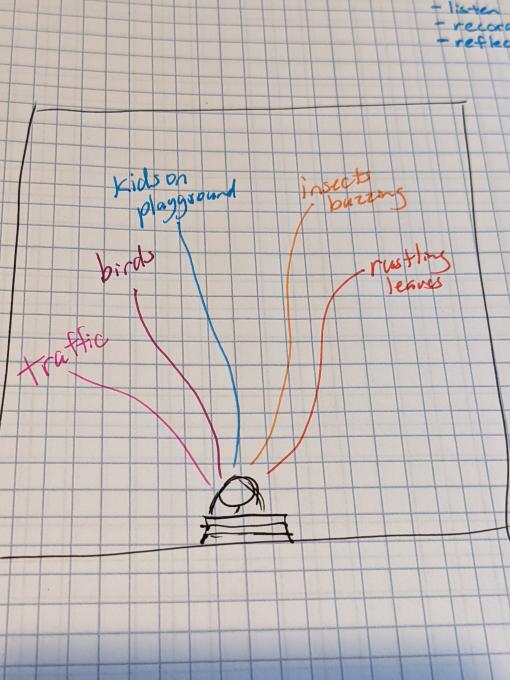
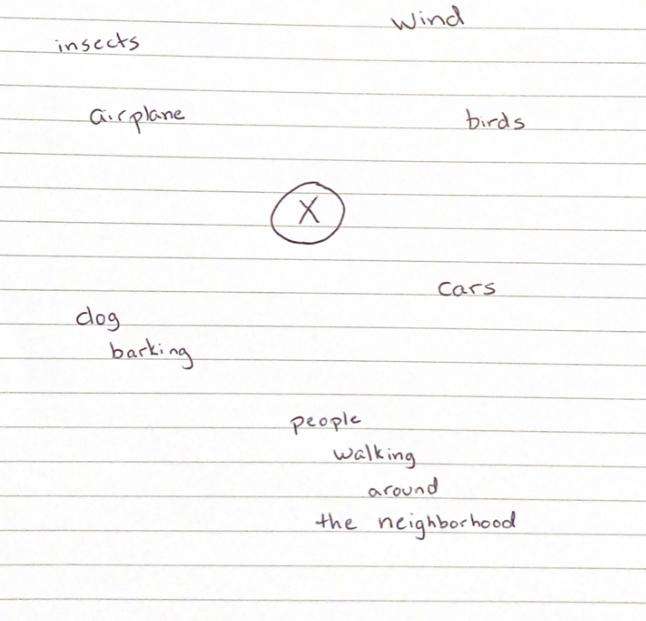
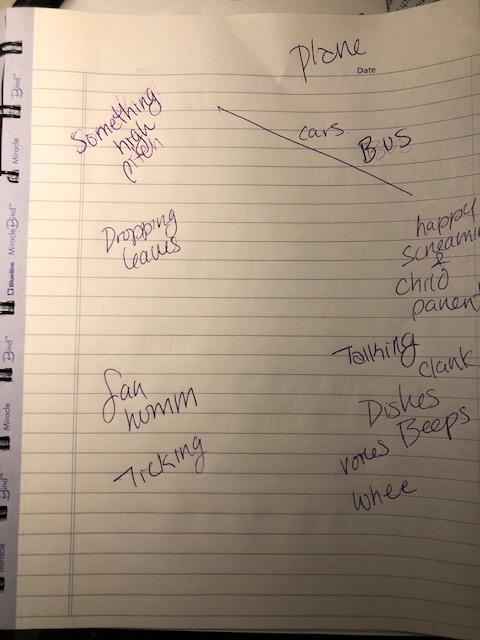 This was a great excuse to go sit outside in the evening! We will be starting a water quality project with students in the fall and doing something similar to this where they could sit and observe all the water in their surroundings could be a neat way to have them start thinking of sources of water and from that research questions. It also breaks down an overwhelming place (the outdoors) into things I can identify or simply notice.
This was a great excuse to go sit outside in the evening! We will be starting a water quality project with students in the fall and doing something similar to this where they could sit and observe all the water in their surroundings could be a neat way to have them start thinking of sources of water and from that research questions. It also breaks down an overwhelming place (the outdoors) into things I can identify or simply notice. 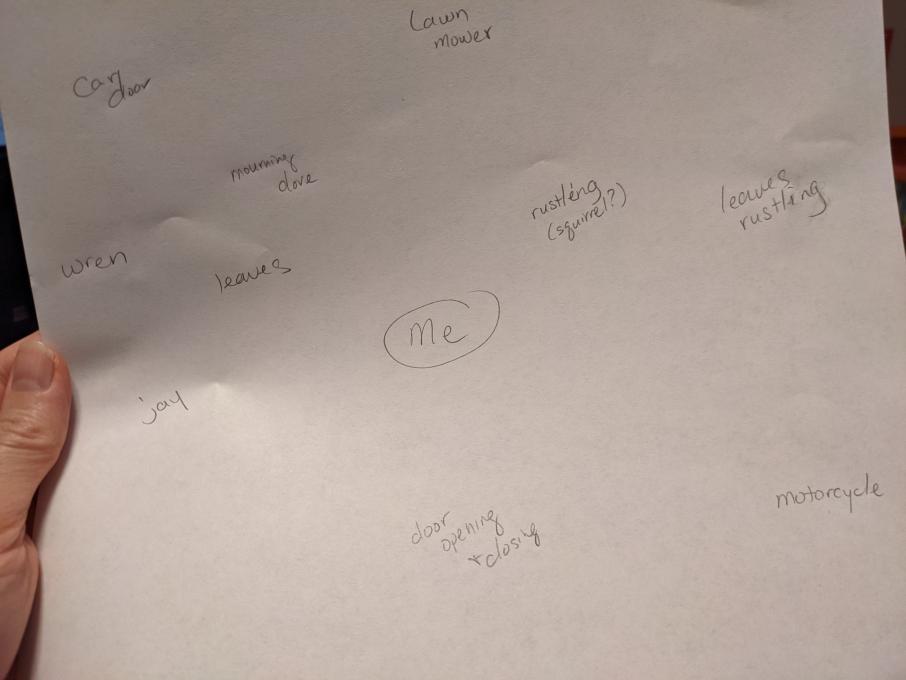 In creating my soundmap I am reminded how many natural sounds there are around us, particularly birds, even though we live in the city. I like April's thoughts on using this activity as a mindfulness exercise for her students. I first discovered sound maps in Joseph Cornell's books. April, there are other minful-type nature activities in his works if you're interested.
In creating my soundmap I am reminded how many natural sounds there are around us, particularly birds, even though we live in the city. I like April's thoughts on using this activity as a mindfulness exercise for her students. I first discovered sound maps in Joseph Cornell's books. April, there are other minful-type nature activities in his works if you're interested. 
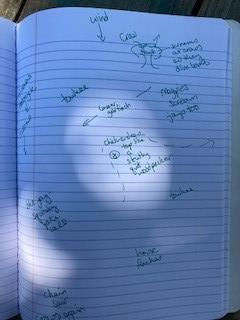
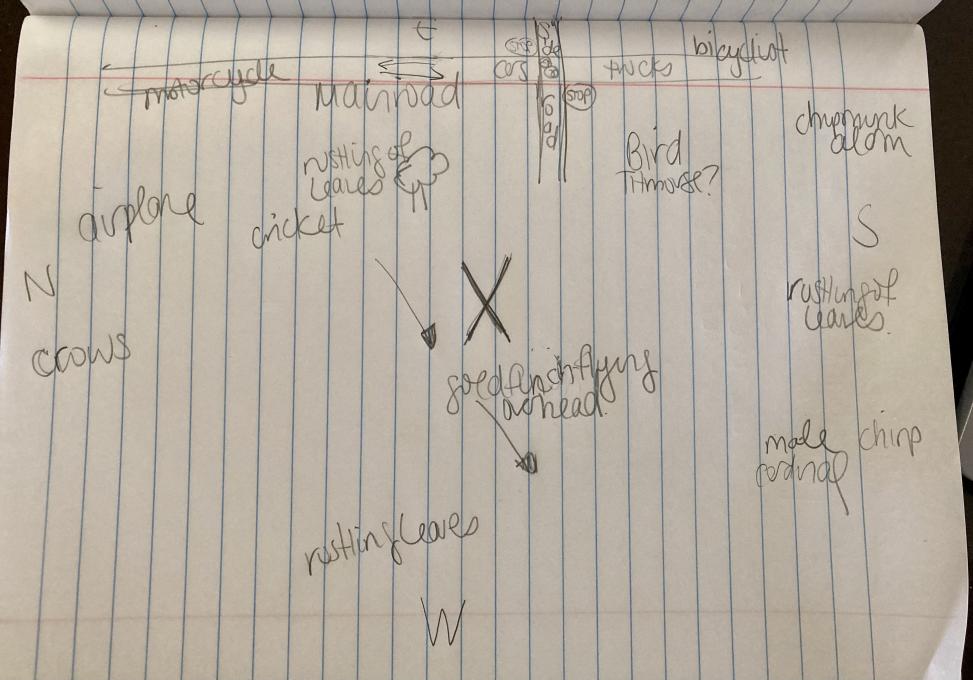
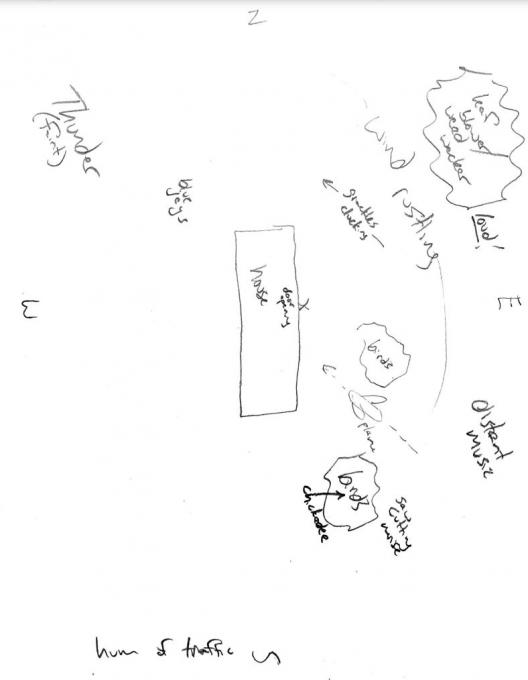 I normally spend time listening, specially during migration (for new yard birds) but this was surprisingly quiet moment EXCEPT for the lawn equipment in the distance! There was thunder off in the distance as a strong approaches. I would love to do this activity with students but perhaps focus the area a bit more. As we plant out our courtyard it would be great for students to "feel" the sounds of nature.
I normally spend time listening, specially during migration (for new yard birds) but this was surprisingly quiet moment EXCEPT for the lawn equipment in the distance! There was thunder off in the distance as a strong approaches. I would love to do this activity with students but perhaps focus the area a bit more. As we plant out our courtyard it would be great for students to "feel" the sounds of nature. 
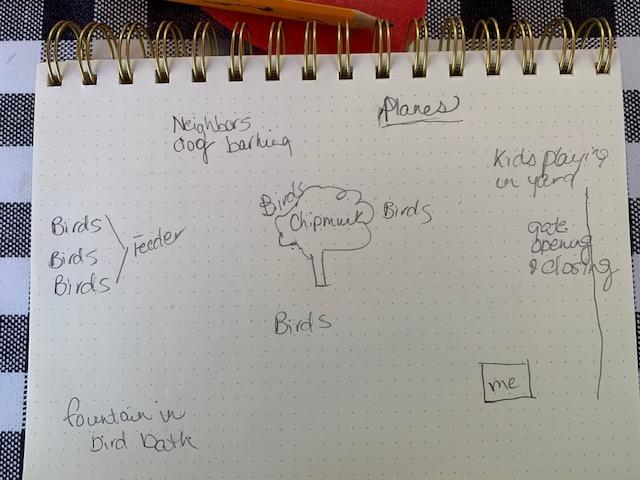
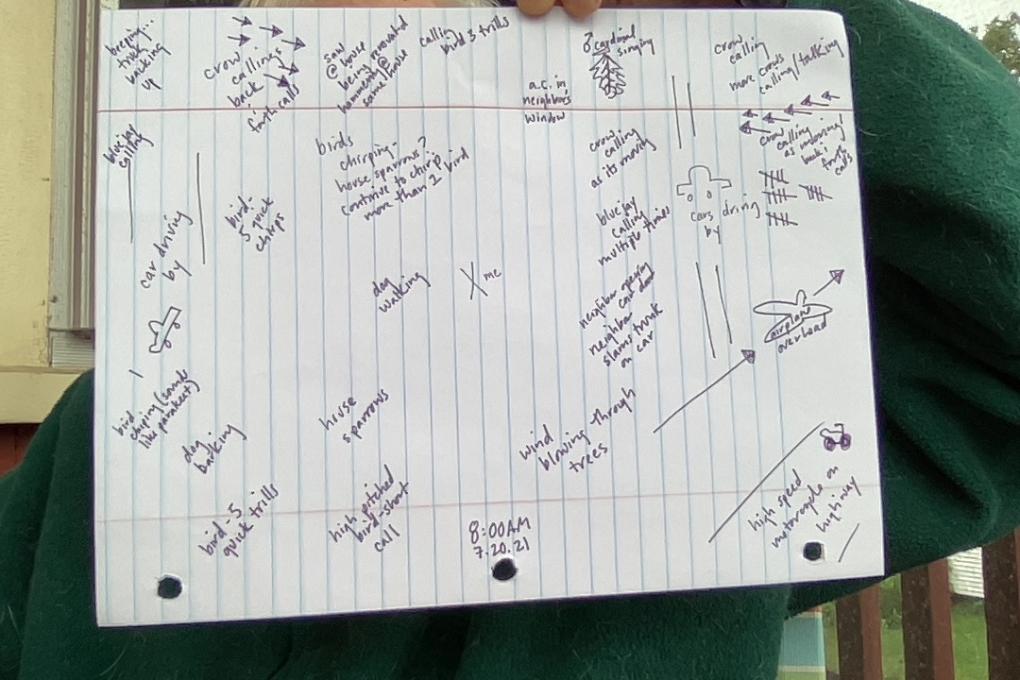 What I found interesting, is the longer I listed the more sounds I heard. During the first 3-4 minutes, I was only recording a few items each minute. During the last 2 minutes, I was hearing so many sounds at once, it was hard to keep up with recording all the sounds I heard. Because we are such visual animals and are use to gaining so much information visually; students need to be coached to be patient as our brain readjusts to focus on auditory observations. A few observations I made which surprised me 1) how much traffic there was along the road North of my position. 2) The calling back and forth between the crows, which lasted for the last 3 minutes. 3) Constant chattering of the house sparrows.
What I found interesting, is the longer I listed the more sounds I heard. During the first 3-4 minutes, I was only recording a few items each minute. During the last 2 minutes, I was hearing so many sounds at once, it was hard to keep up with recording all the sounds I heard. Because we are such visual animals and are use to gaining so much information visually; students need to be coached to be patient as our brain readjusts to focus on auditory observations. A few observations I made which surprised me 1) how much traffic there was along the road North of my position. 2) The calling back and forth between the crows, which lasted for the last 3 minutes. 3) Constant chattering of the house sparrows. 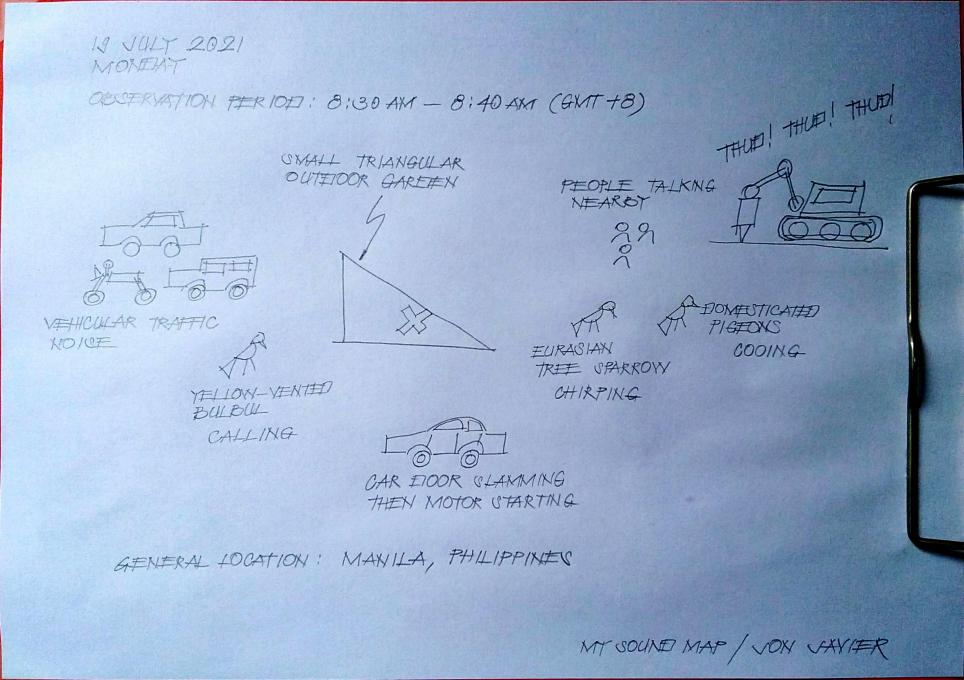

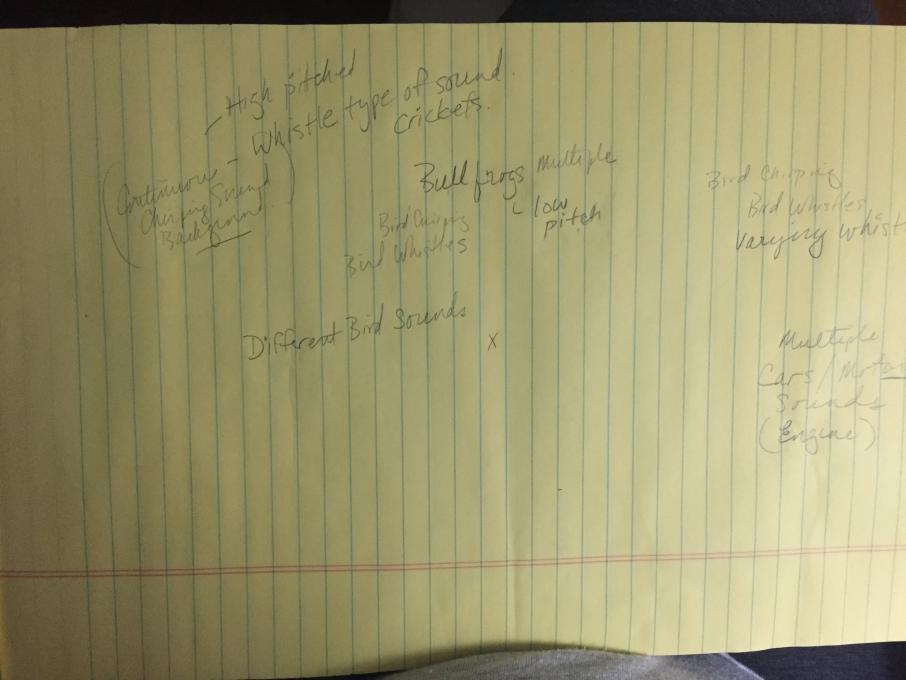
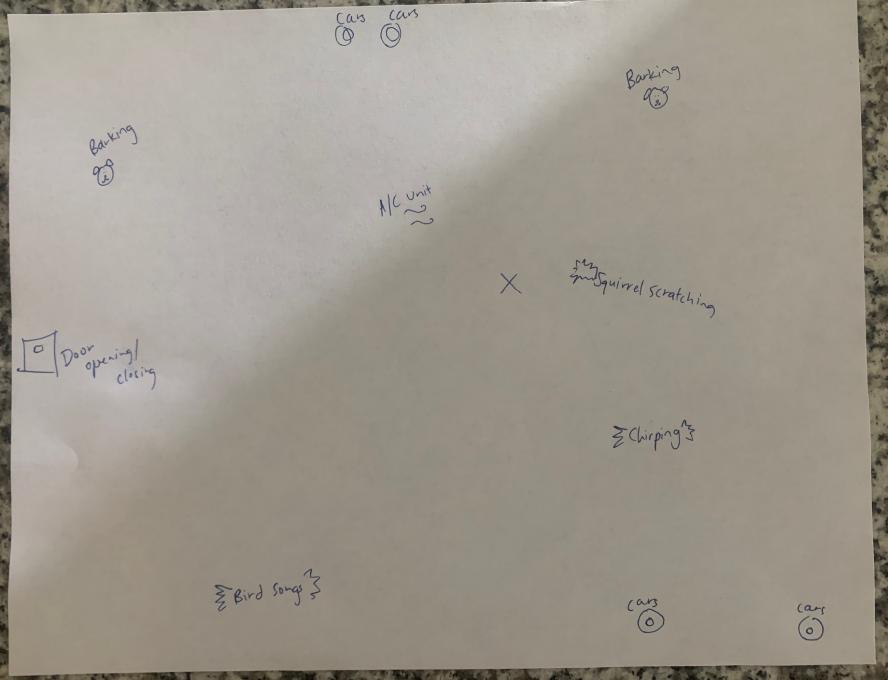
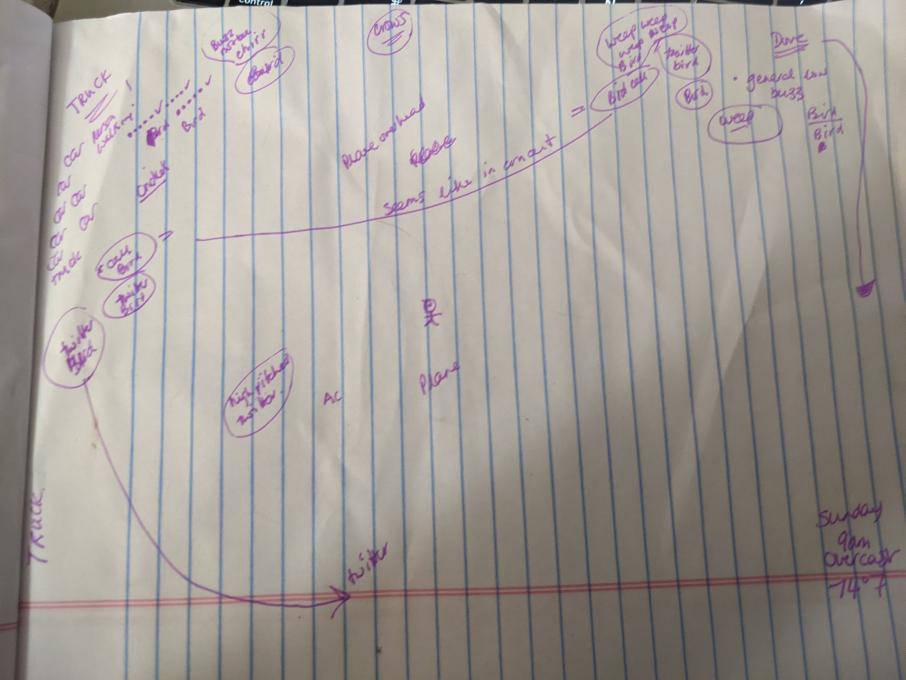
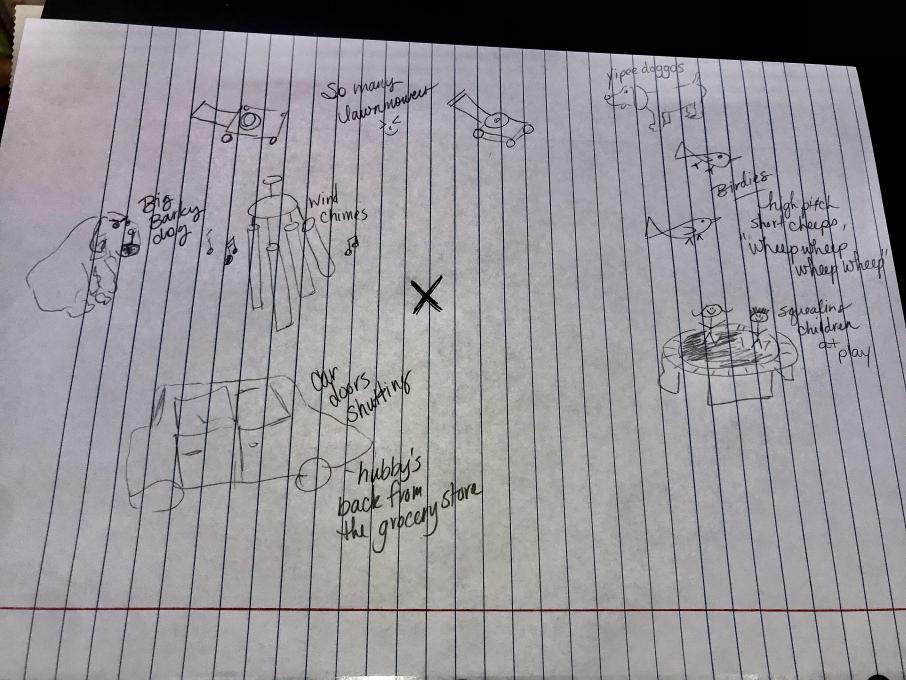
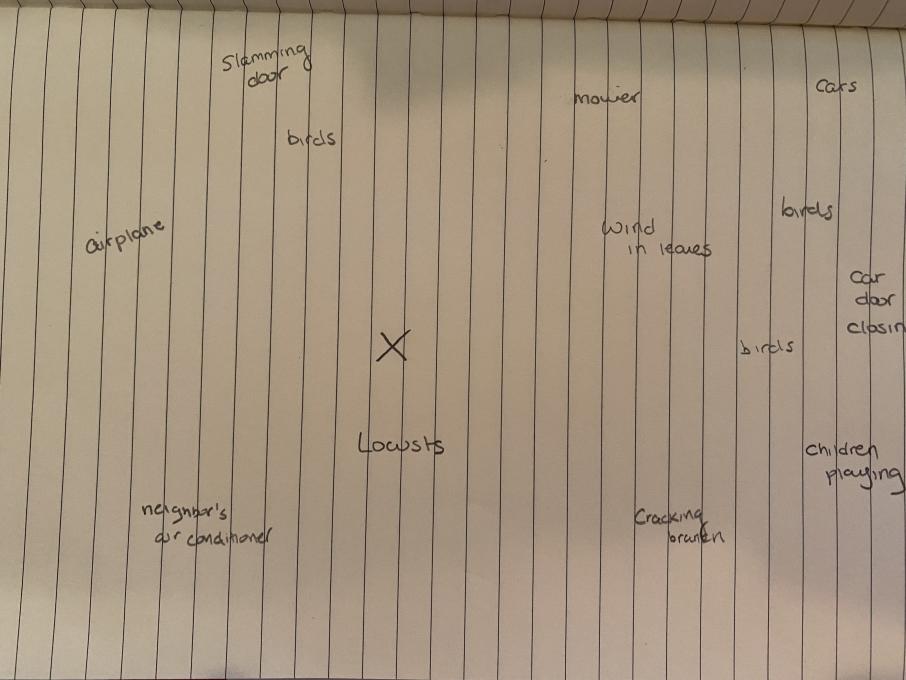
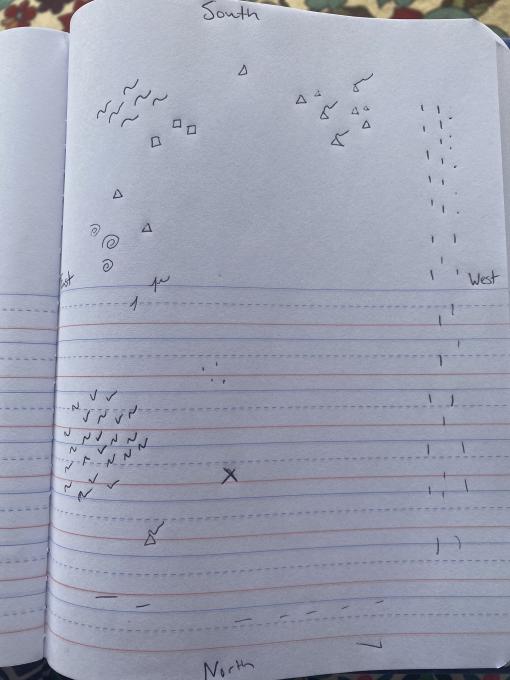

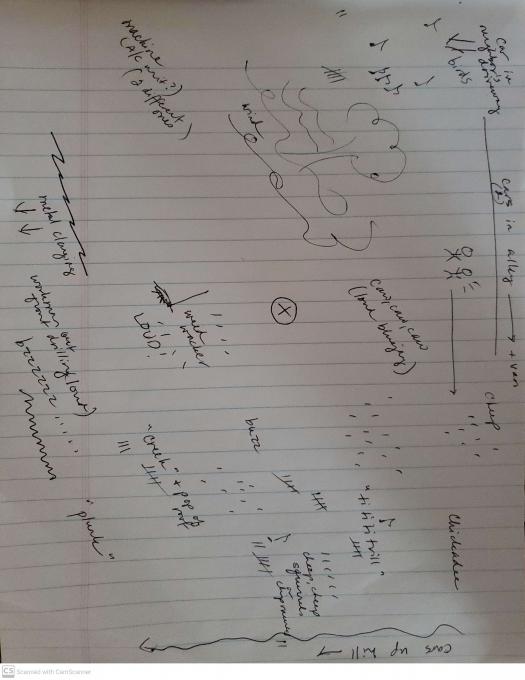
 The most impactful thing was how LOUD sitting QUIET is sometimes. We practice using our senses a lot in our programs when we are out in nature. I've created all these practices based off of my own experience with opening my senses but now that I'm the mentor it's easy to slip out of practice and focus on being the teacher instead of the learner. We utilize an incredible nature awareness book written by Jon Young called Coyote's Guide to Connecting with Nature for a lot of our nature senses activities and I would highly recommend that book to any informal or non-formal educator. We are lucky enough to have 40 acres on our organizations property that we can utilize for activities and lessons. Over the years my students have started to develop trails, outdoor classrooms, and most of all, connections to our mountainside in the Rocky Mountains.
The most impactful thing was how LOUD sitting QUIET is sometimes. We practice using our senses a lot in our programs when we are out in nature. I've created all these practices based off of my own experience with opening my senses but now that I'm the mentor it's easy to slip out of practice and focus on being the teacher instead of the learner. We utilize an incredible nature awareness book written by Jon Young called Coyote's Guide to Connecting with Nature for a lot of our nature senses activities and I would highly recommend that book to any informal or non-formal educator. We are lucky enough to have 40 acres on our organizations property that we can utilize for activities and lessons. Over the years my students have started to develop trails, outdoor classrooms, and most of all, connections to our mountainside in the Rocky Mountains.